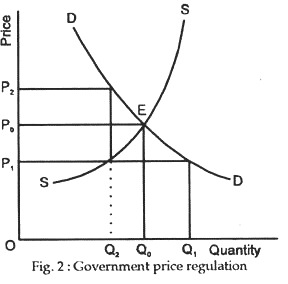The term ‘price control’ implies the fixation of either the maximum or the minimum prices of some selected essential commodities. But the fixation of the maximum prices during inflation is more common than that of the minimum prices during deflation. Other weapons of price control are taxation (to raise prices) and subsidies (to reduce prices).
The term ‘rationing’ denotes the imposition of restriction on the consumption of some essential, scarce commodities, such as rice, wheat, pulses, clothes, sugar, etc., during the period of rising prices. Rationing seems to be a ‘fair’ way of sharing out limited supplies of essential commodities since everyone gets the same amount at a fixed price.
Objectives:
Price control and rationing are usually adopted during wartime to meet the shortages of essential goods and to control war time inflation. Even during peace time these may be adopted as anti-inflationary measures as found at present in our country.
ADVERTISEMENTS:
These measures have some objectives:
(a) Maintaining stability of the prices of essential goods and preventing inflationary rise in prices,
(b) Protecting the interest of consumers through the supply of essential goods at controlled prices,
(c) Protecting the interest of the producers through the minimum guarantee prices for selected goods, especially agricultural products,
ADVERTISEMENTS:
(d) An equitable sharing out of the scarce, essential goods among the people, and
(e) Reducing the effects of inequality of wealth by fixing the per head quota of each of the essential goods.
Illustration:
The theory of price determination through the interaction of demand and supply breaks down during war time when government passes laws fixing the maximum prices at which commodities, mostly necessities, can be sold. Figure 2 shows the demand and supply curves for a particular commodity. The equilibrium price is OP0 and the equilibrium quantity is OQ0.
ADVERTISEMENTS:
What happens if the government tries to regulate or control the price at a level below the equilibrium one, say, at OP1 (floor price)? When price is reduced from OP0 to OP1 by deliberate government action the quantity demanded expands from OQ0 to OQ1, contrarily the quantity supplied falls from Q1 to Q2. Thus, a w scarcity will emerge; there will arise £ excess demand (i.e., demand exceeding supply).
So, the available supply will have to be allocated among the eager demanders. The government will have to introduce some sort of rationing by issuing ration cards or coupons to consumers, as is done during war and emergency.
Otherwise, the eager demanders will bid (push) up the price above the equilibrium level, to say OP2. So, some indirect methods of paying the higher price will emerge: black marketing will develop because the purchasers would be bidding to pay much more than the controlled price for the limited amount of the commodity that were available.
Limitations and Difficulties:
Price control-cum-rationing is imposed in case of essential commodities to suppress the effects of inflation. But rationing and control is not possible in case of all commodities. There are certain disadvantages of this method of allocation.
First, prices in uncontrolled sectors rise disproportionately. Secondly, it prevents people from buying desirable goods and services and thus reduces incentives to work. Thirdly, it distorts consumer preferences and induces people to spend more on uncontrolled goods. Fourthly, black markets come into existence and working of the free-market mechanism may be hampered. Finally, a considerable amount of manpower is kept in administering the controls.
So, price control and rationing has a limited effect. Statistical evidence shows that they merely suppress the symptoms of inflation without curing the disease itself.
